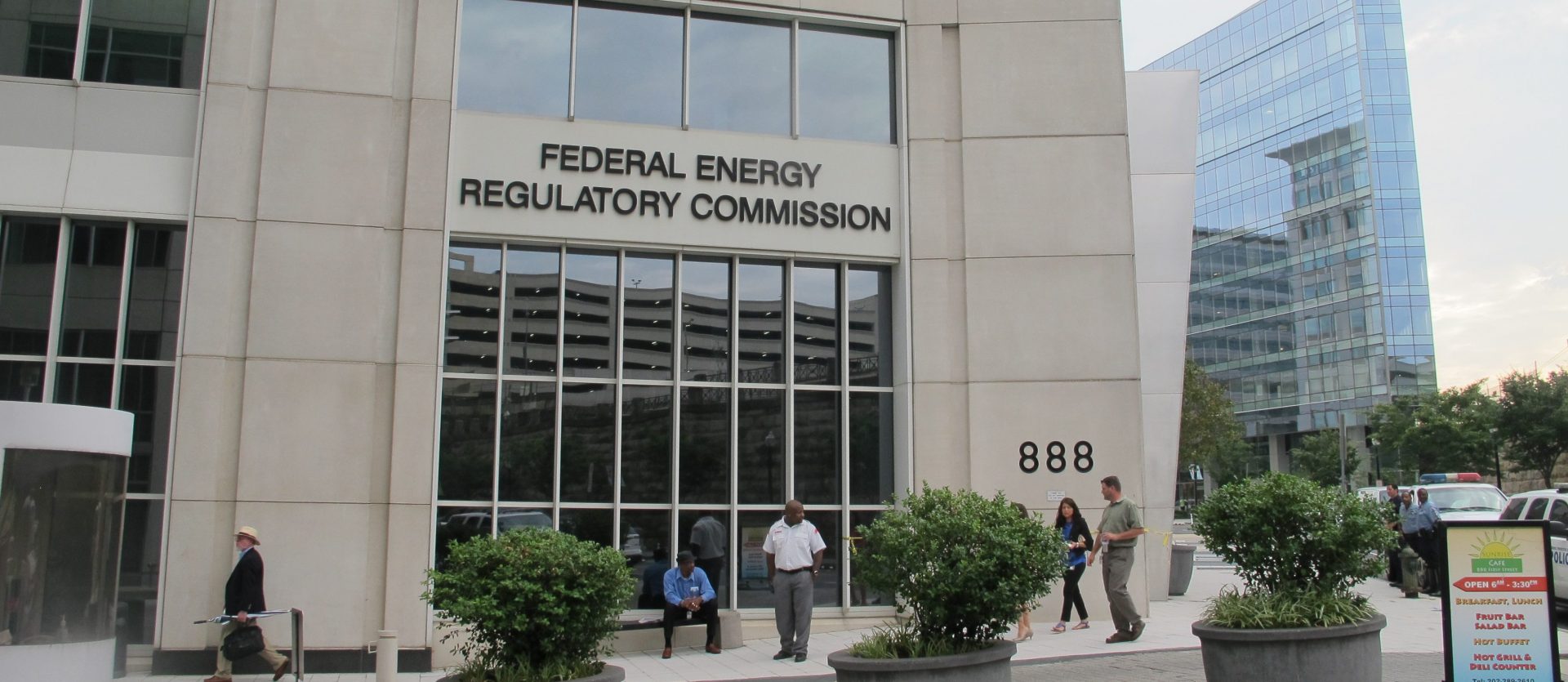
The FERC building in Washington D.C.
Marie Cusick/ StateImpact Pennsylvania


The FERC building in Washington D.C.
Marie Cusick/ StateImpact Pennsylvania

Marie Cusick/ StateImpact Pennsylvania
The FERC building in Washington D.C.

Jon Hurdle / StateImpact PA
Roy Christman (left) and William Kellner protested plans to build the PennEast natural gas pipeline at a FERC ‘listening session’ near Jim Thorpe, Pa. in 2016. FERC has now approved the project.
The PennEast pipeline project took a step forward late Friday when federal regulators decided the company could start construction and potentially use eminent domain to take private land in Pennsylvania and New Jersey.
Other permits from New Jersey and the Delaware River Basin Commission are needed before construction can begin.
The Federal Energy Regulatory Commission granted the PennEast Pipeline Co. a “certificate of public convenience and necessity” to build the pipeline, and said it accepts that the company has obtained commitments from 12 named customers to buy about 90 percent of the natural gas that would be carried by the line.
The contracts show there is a need for the pipeline “given the substantial financial commitment required under these contracts by project shippers,” FERC said in an 84-page document that describes its evaluation of the project.
It rejected arguments by opponents including the New Jersey Rate Counsel, an advocate for utility ratepayers, who say there is no need for the approximately 120-mile line that would carry natural gas from the Marcellus Shale of Luzerne County, Pa. to Mercer County, N.J.
The five-member commission said it is “unpersuaded” by studies showing insufficient demand for the project, based on projections of future demand for natural gas in Pennsylvania and New Jersey. It said those projections were subject to uncertainties including gas prices, economic growth and regulation, and so it sees PennEast’s contracts as a better indicator.
Dissenting commissioner criticizes decision
Critics say the contracts are not a true indication of demand because some are with affiliates of PennEast. That argument was also used by Commissioner Richard Glick, the sole dissenter, who said the contracts are “not necessarily the result” of negotiation between PennEast and independent entities.
“By itself, the existence of precedent agreements that are in significant part between the pipeline developer and its affiliates is insufficient to carry the developer’s burden to show that the pipeline is needed,” Glick wrote.
Instead of relying only on the supply contracts, Glick wrote, the commission should have based its decision on factors including the projected demand for natural gas, the overall availability of pipeline capacity, and an assessment of how much gas customers would save from new PennEast supply.
But since it didn’t take those factors into account, its conclusion that the pipeline is needed was not properly taken, he said.
In November, a report for the Natural Resources Defense Council fueled concern about natural gas pipeline overbuilding when it said FERC had approved more than twice as much capacity in the past two decades than was actually consumed daily in 2016.
FERC’s order also rejected a call for an evidentiary hearing on PennEast by Eastern Environmental Law Center, a nonprofit that represents the New Jersey Conservation Foundation, an opponent of the pipeline. FERC said it had sufficient written evidence to make its decision and saw no need for an oral hearing.
Jennifer Danis, an attorney with EELC, said FERC’s reliance on written sources in assessing the need for the pipeline was problematic, and that the group will ask for a rehearing.
“FERC’s rationale for saying it can decide on the ’papers’ came down to checking the box that it had the only paper it needed — private contracts,” Danis told StateImpact.
Still, the regulator set more than 50 conditions for its approval, including a requirement that the company’s ability to take land through eminent domain is limited to the project as authorized, and cannot be extended in anticipation of any future expansion.
Project still needs more permits
While the FERC approval is a boost for the $1 billion project, it still needs permits from the Delaware River Basin Commission and from New Jersey’s Department of Environmental Protection, which in June 2017 rejected PennEast’s application for a water-quality permit, saying it hadn’t received enough information from the company despite previously giving it more time to complete the application. The company said then that it would reapply.
In New Jersey, where the project has generated strong opposition in some affected communities, critics hope PennEast will be blocked by the administration of the new Democratic Governor, Phil Murphy, who supports a switch to renewable energy.
According to the New Jersey Conservation Foundation, about 200 landowners along that state’s portion of the route, or about two-thirds of the total, have declined PennEast’s offers of compensation.
PennEast welcomed FERC’s decision as a “major victory” for natural gas customers who will benefit from lower gas and electricity costs, more reliable service, and better air quality as customers shift away from coal and oil.
Spokeswoman Patricia Kornick said the company now has the option of beginning eminent domain actions against uncooperative landowners but will always try to reach “fair compensation agreements” with them to obtain a portion of their land under which the pipeline would be built.
The company expects to start construction this year and for the pipeline to be operational in 2019, Kornick said.
She declined to say whether the company would start construction before the remaining state and DRBC permits are received. She said PennEast should not be compared with the proposed Constitution Pipeline from Pennsylvania to New York, for which workers began to clear trees in northeastern Pennsylvania in early 2016 before receiving permits from the New York portion of the route – permits that were later denied. FERC recently upheld New York’s denial of the Constitution permits in the latest blow to that project.
FERC’s decision, though months later than PennEast publicly predicted, was not unexpected from an agency that approves almost all pipeline applications that come before it.
Still, it prompted protests from environmental groups that have focused public opposition to the project since it was proposed in 2014.
“FERC pledged its allegiance to the natural gas pipeline industry once again with its approval of the PennEast pipeline,” said Karen Feridun of Berks Gas Truth. “The opposition to the PennEast pipeline is widespread, dedicated, on the right side of the issues, and more determined than ever to win.”
Lynda Farrell, executive director of the Pennsylvania-based Pipeline Safety Coalition, said she was disappointed but not surprised by FERC’s action, and said opponents would continue to fight the project.
“The placement of PennEast in the Delaware River Basin, impacts on historic and cultural resources, community and environmental safety have always been, and will continue to be an issue that raises the question of why FERC would approve this project under the guise that the benefits outweigh the adverse effects,” Farrell said.
This story has been updated to show the number of contracted shippers of PennEast gas that are affiliated with the company.
StateImpact Pennsylvania is a collaboration among WITF, WHYY, and the Allegheny Front. Reporters Reid Frazier, Rachel McDevitt and Susan Phillips cover the commonwealth’s energy economy. Read their reports on this site, and hear them on public radio stations across Pennsylvania.
(listed by story count)
StateImpact Pennsylvania is a collaboration among WITF, WHYY, and the Allegheny Front. Reporters Reid Frazier, Rachel McDevitt and Susan Phillips cover the commonwealth’s energy economy. Read their reports on this site, and hear them on public radio stations across Pennsylvania.
Climate Solutions, a collaboration of news organizations, educational institutions and a theater company, uses engagement, education and storytelling to help central Pennsylvanians toward climate change literacy, resilience and adaptation. Our work will amplify how people are finding solutions to the challenges presented by a warming world.